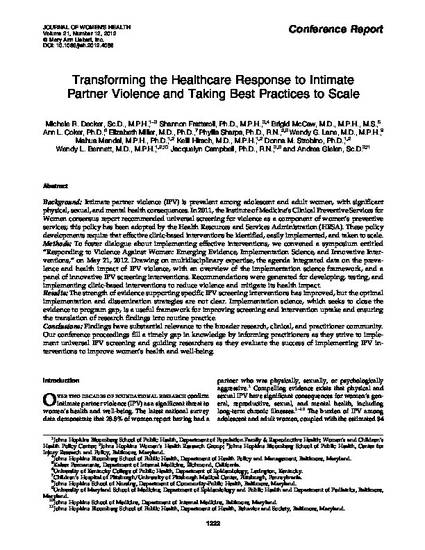
BACKGROUND: Intimate partner violence (IPV) is prevalent among adolescent and adult women, with significant physical, sexual, and mental health consequences. In 2011, the Institute of Medicine's Clinical Preventive Services for Women consensus report recommended universal screening for violence as a component of women's preventive services; this policy has been adopted by the Health Resources and Services Administration (HRSA). These policy developments require that effective clinic-based interventions be identified, easily implemented, and taken to scale.
METHODS: To foster dialogue about implementing effective interventions, we convened a symposium entitled "Responding to Violence Against Women: Emerging Evidence, Implementation Science, and Innovative Interventions," on May 21, 2012. Drawing on multidisciplinary expertise, the agenda integrated data on the prevalence and health impact of IPV violence, with an overview of the implementation science framework, and a panel of innovative IPV screening interventions. Recommendations were generated for developing, testing, and implementing clinic-based interventions to reduce violence and mitigate its health impact.
RESULTS: The strength of evidence supporting specific IPV screening interventions has improved, but the optimal implementation and dissemination strategies are not clear. Implementation science, which seeks to close the evidence to program gap, is a useful framework for improving screening and intervention uptake and ensuring the translation of research findings into routine practice.
CONCLUSIONS: Findings have substantial relevance to the broader research, clinical, and practitioner community. Our conference proceedings fill a timely gap in knowledge by informing practitioners as they strive to implement universal IPV screening and guiding researchers as they evaluate the success of implementing IPV interventions to improve women's health and well-being.
Available at: http://works.bepress.com/anncoker/93/

Published in Journal of Women's Health, v. 21, no. 12, p. 1222-1229.
This is a copy of an article published in the Journal of Women’s Health © 2012 Mary Ann Liebert, Inc.; Journal of Women’s Health is available online at: http://online.liebertpub.com/loi/jwh